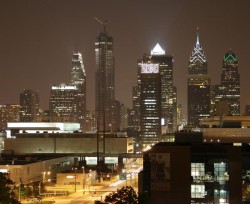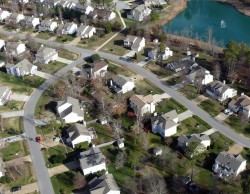Hillary Kelly takes issue with suburbanites claiming the city as their own:
These hometown fabulists—let’s call them Faux Urbanites—defend themselves by claiming it’s easier to name the nearest big city as your hometown than to explain where exactly Strasburg, Colorado, is. Recently, an article in The Atlantic’s CityLab backed up that very argument, saying, “At simplest, it’s a matter of convenience; it can indeed be easier, and faster, to tell someone whom you assume does not know the intricacies of New England that you’re from Boston, when in fact you’re from Cumberland, Maine.” But it really isn’t that taxing to add a few short words that properly explain a town’s location. It’s just four short syllabic steps from “I’m from Los Angeles” to “I’m from a suburb of Los Angeles.” And from there, it’s just a few more words of explanation to start coloring in the details of your upbringing.
Freddie deBoer and Alan Jacobs take issue with this. Both accuse her mostly of posturing. But if one is proud of where they come from, I can see why they might be frustrated by people on the outside of it claiming the same.
 The problem is that “inside” and “outside” really are not rigidly defined. Multiple people in Freddie’s commenters pointed out that Philadelphia in particular is a bad example, because many people who live in Philly proper actually live in what would be the suburbs in some other city. Colosse has little townlets right near downtown Colosse, and you can be fifteen miles away from downtown and still be in Colosse proper.
The problem is that “inside” and “outside” really are not rigidly defined. Multiple people in Freddie’s commenters pointed out that Philadelphia in particular is a bad example, because many people who live in Philly proper actually live in what would be the suburbs in some other city. Colosse has little townlets right near downtown Colosse, and you can be fifteen miles away from downtown and still be in Colosse proper.
Mostly, though, the cities are organisms much larger than their flagship. Philadelphia wouldn’t be what it is without its suburbs. Those cool things that exist downtown? A lot of them exists due to a customer base that extends into New Jersey and elsewhere. Without the suburbs, Philadelphia has roughly the population of Raleigh-Durham or Virginia Beach. And Philadelphia has wide city limits and is the fifth largest municipality in the country, so it’s not even a suburb-heavy place like Seattle. People in the city talk about how the suburbanites need the urban core for jobs, but urban employers rely on an employee pool that leans heavily on the suburbs. And suburban employers rely on commuters from the city and other suburbs, and on and on.
 I used to actually say “I am from Mayne” or “I am from Southfield” or “I am from half way between Colosse and Surfenberg.” But then I attended Southern Tech. I got jobs inside and outside the city limits, I lived inside and outside city limits, and the longer you are in a place, the more it genuinely blends together. Which is why New Jersey’s football teams are called New York and Santa Clara is about to get a football team that’s going to keep the San Francisco name. And why I really don’t consider it remotely dishonest to say “I was raised in Colosse.”
I used to actually say “I am from Mayne” or “I am from Southfield” or “I am from half way between Colosse and Surfenberg.” But then I attended Southern Tech. I got jobs inside and outside the city limits, I lived inside and outside city limits, and the longer you are in a place, the more it genuinely blends together. Which is why New Jersey’s football teams are called New York and Santa Clara is about to get a football team that’s going to keep the San Francisco name. And why I really don’t consider it remotely dishonest to say “I was raised in Colosse.”
About the Author
11 Responses to The Patron Saints of Elsewhere
Leave a Reply
please enter your email address on this page.

I always told people not-from-Ohio I grew up “roughly midway” between Cleveland and Akron, because relatively few people not-from-there know all the various small towns. I wasn’t claiming any affiliation with either city (In fact, I think I went to Cleveland a total of three times in the 20 years I lived in Ohio, and one of those times was to go to a baseball game).
I will say there’s always a feeling of companionship when I meet someone somewhere who turns out to be from (for example) Medina or Twinsburg, then I can tell them right where I grew up and they know.
Right now, where I live, it’s so distant from any big city (Dallas is the closest one but they’re in another state) that I just name the city and then give the general geographical attributes.
To people familiar with Ohio, I often say I grew up 30 minutes south of Cedar Point. Even out-of-staters sometimes get the reference, as it’s a popular theme park.
Also, when I was really young (4th grade or so) we lived near Canton. Luckily, it’s where the Pro Football Hall of Fame. (Alas, the McKinley Memorial just doesn’t have the same name recognition.)
“Midway between X and Y” is a pretty good way to go, when applicable. Most people don’t particularly know that Akron is a 45 minute drive from Cleveland and so they might think you’re around Columbus or something, but there’s no accounting for geographical ignorance.
The problem is that “inside” and “outside” really are not rigidly defined.
The real problem is that most people lack the wide depth of geographic knowledge to describe their region to others who aren’t from it. When I’m out of state, I’ll state that I’m from New York, although, Long Island is somewhat well known as a region when compared to say, “South Jersey”. I wouldn’t expect someone to know where East Meadow or Cherry Hill would be located, and even if I point out that I’m from the town where Lindsay Lohan grew up, I’m well aware that most people wouldn’t be able to point it out on a map. So I’ll give some credit to somebody in a metro area that says they’re from the main city. As long as they’re open about living in the suburbs or exurbs, I don’t see any problem.
To me, at least, when people outside the area ask where you’re from, they primarily want a point of reference. For New Jersey, “north” and “south” actually provides that pretty well, since it’s a vertical state. Usually, though, the flagpoll is the city. If a person cares whether you live in the city or the suburbs, they can always ask.
For New Jersey, “north” and “south” actually provides that pretty well, since it’s a vertical state.
The problem is that a lot of people just lump the entire state together into one big stereotype. I suspect it’s easier for South Jersey residents to claim Philadelphia than to say “New Jersey”, as most of the stereotypes of New Jersey are proxies for NYC influenced North Jersey. Just as one wouldn’t say Philadelphia is the same as NYC, one shouldn’t make the same implication for New Jersey.
This was a difficult question for me when I was living in Connecticut. While it was my impression that most people from elsewhere in the country had heard of my specific city, which has a population in excess of 100,000, not many people from outside the region know where in the state it is located. As it was a city in its own right and not a suburb I couldn’t use the “suburb of X” response. Most often I’d just say that it was in the western part of the state.
I just realized that I am bizarrely ignorant of the layout of Connecticut. Other than presumably the NYC suburbs being in the southern reach.
Don’t worry, I suspect many of us would be just as bad in regards to other regions.
FWIW, while there are a few commuters to NYC from New London, Waterbury, and Litchfield County, “suburban” areas are a proxy for Fairfield County. New Haven is the furthest extend of Metro North, and beyond there the service drops off considerably with Amtrak and Shore Line East taking over. New Haven rarely gets much coverage in NYC media, but IIRC, gets local coverage from Hartford. Of course, one could argue that New Haven’s role in being the split between Hartford and New York isn’t too dissimilar from the role that Trenton plays in dividing New York from Philadelphia.
As a bonus, I’d note that the Sandy Hook shooting was covered as a *local* story since the town is just outside of Danbury, CT.
I tend to pride myself on my knowledge of American geography, and I just found an apparent blindspot. I’ll need to bush up!
Just don’t ask me to become knowledgeable about Rhode Island. I mean, pretty much the whole state is covered by Providence. Right? Right?!
I’ve driven through Rhode Island, and it’s a very quick drive on I-95 even though you cross the state in a nearly diagonal line. Other than Newport and Block Island, there isn’t that much else to the state. Providence isn’t that big, and what isn’t Providence metro is basically no different than rural Eastern CT.